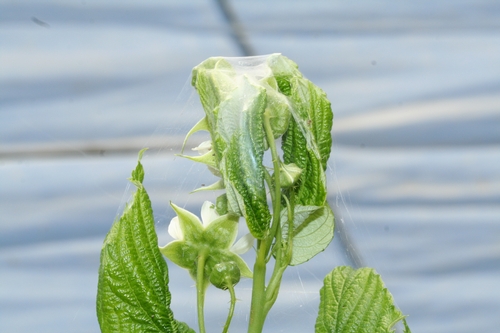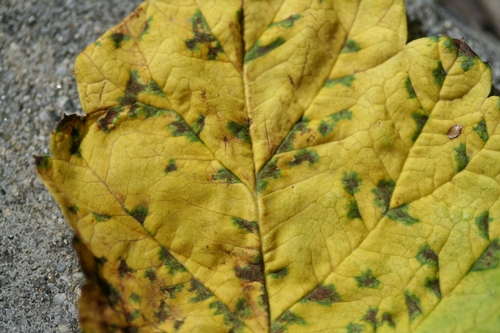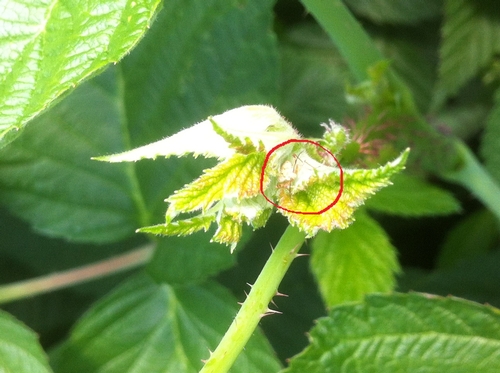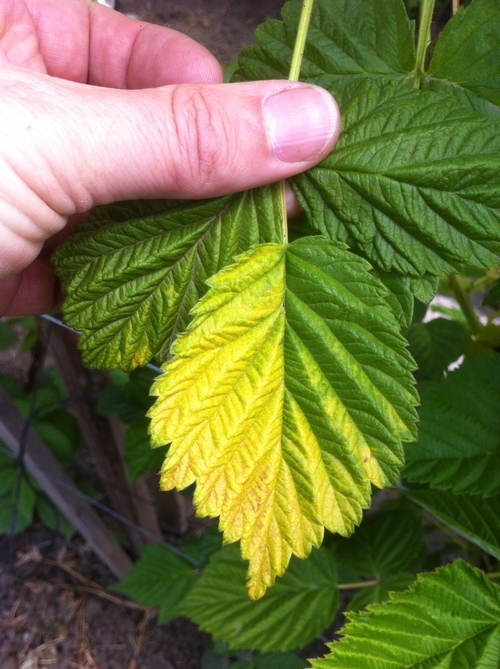
Posts Tagged: raspberry
Spiders, Spiders Everywhere
Here's one that I've never seen before. True spiders with webbing so heavy that it could interfere with the growing point of raspberry.
On approaching the field, once notices a lot of the very top of many raspberry plants in this field under tunnels with those leaves rolled up. Of course this sets off alarm bells that it could be LBAM, but closer inspection reveals a far heavier webbing than is customary for a leafroller. And... lots and lots of spiders.
What would the call be to do about this? Hard to say, readers if you have experience and/or suggestions what to do, write in and I'll post your answer.
Pics taken today of the situation posted below.

Problem seen from afar - growing point curled into a ball.

Copious amounts of webbing.

Excessive webbing unfurling from plant.

Webbing in association with spiders - one on the top of the leaf, a bigger one under.

Spider close up - anybody know the species?
Rust on Raspberry
Yellow rust on raspberry has been a common issue of concern for growers and PCA's this past week, very likely this has been spurred on by the wet weather of this past winter.
Recommendations for management available at the UC IPM guidelines
http://ucipm.ucdavis.edu/PMG/r71101111.html
The pictures below are of what some of this rust manifests itself as. Viewing the leaf from the top, one sees an array of darker spots over a lighter background of the chlorotic leaf (not diagnostic, nor do I make any pretensions that this is being caused by the rust disease). Turning the leaf over, one can see the masses of pustules growing at these very spots.

Yellow rust affected leaf; top view.

Yellow rust on raspberry leaf, bottom view.
Lygus in Raspberry
A couple of pictures below from a farm call concerning unusual damage on the tips of growing raspberry. Some of the leaves are affected as in Photo #1, but others are pretty well aborted and not growing at all. Incidence wasn't more than 5%, but still this is disconcerting and I was over at the grower field within 15 minutes to take stock of the situation. No flowers or fruit yet on the plants.
No signs of frass or webbing that would be associated with leafrollers (some like to feed at the nitrogen rich tips), and I've checked this sort of thing in caneberries before and haven't found that viruses or nutrients are at cause either.
But we did find lygus and Photo #2 explains that we may have identified the cause. While some lygus were to be found wandering around on leaves, others were nestled in the growing point of the plant, which on the very young leaf can show up as a lot of damage later on when it fully expands. It's quite possible that this insect activity could be causing the tip to die entirely in a situation reminiscent of "black flagging" in cotton, which is the death of terminals in cotton caused by lygus feeding.

Leaf damage on raspberry, possibly from lygus.

Lygus (circled in red) nestled in the very point of the growing raspberry.

Lygus climbing out of its feeding spot in and resting on an aborted growing point in raspberry. Photo courtesy Nazario.
Farm Call: Yellow Leaves on Raspberry in Tunnels
I was called out last week to evaluate the following situation, which I am sure is not at all unfamiliar to any of you who spend time working with raspberries under tunnels. Symptoms, as shown in the pictures below, consist of very obvious yellowing, sometimes half the leaf, sometimes less, sometimes more, started a few days after the tunnels went up and a run of hot days.
Consistent with the work we have done on this issue in the past, it's fairly clear that the leaves are dying from the high temperatures in the newly erected tunnels. The elements nitrogen, phosphorous and potassium are being remobilized from the yellow leaves to newer leaves on the plant, while others, markedly calcium, are left behind or continue to accumulate (look at the large differences between iron and boron in healthy green leaves as compared to yellow leaves). Curiously, copper trends high in both – usually I see that around 2 or 3 parts per million.
Recommendation to the grower last week when I took the samples was to vent the tunnels by moving the plastic up a bit, and happily he reports an improvement in the plants already.
|
Element |
Green Leaves |
Yellow Leaves |
|
Nitrogen (%) |
3.30 |
2.34 |
|
Phosphorous (%) |
0.23 |
0.10 |
|
Potassium (%) |
2.06 |
1.25 |
|
Calcium (%) |
0.65 |
1.02 |
|
Magnesium (%) |
0.29 |
0.46 |
|
Sodium (%) |
0.03 |
0.05 |
|
Iron (ppm) |
83 |
165 |
|
Boron (ppm) |
95 |
167 |
|
Zinc (ppm) |
15 |
24 |
|
Copper (ppm) |
7.4 |
8.7 |
|
Manganese (ppm) |
89 |
123 |

One half of the leaf yellow, and the other half green.

Yellowing even more pronounced on a single leaflet, discoloration divided right down the midvein.

Whole leaf in decline, only green left in the veins.
Post harvest Powerpoint for Raspberries and Blackberries
Excellent Powerpoint given by UC Davis' Marita Cantwell at Oleg Daugovish's caneberry meeting this past April. Probably the best you are going to find anywhere concerning post harvest handling of these delicate fruits:
http://ceventura.ucanr.edu/files/188522.pdf
